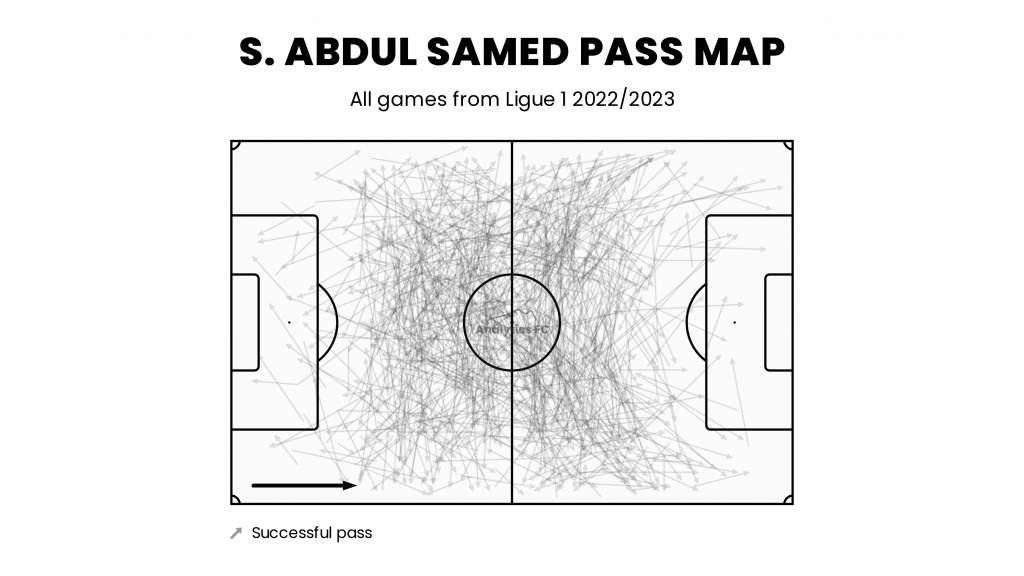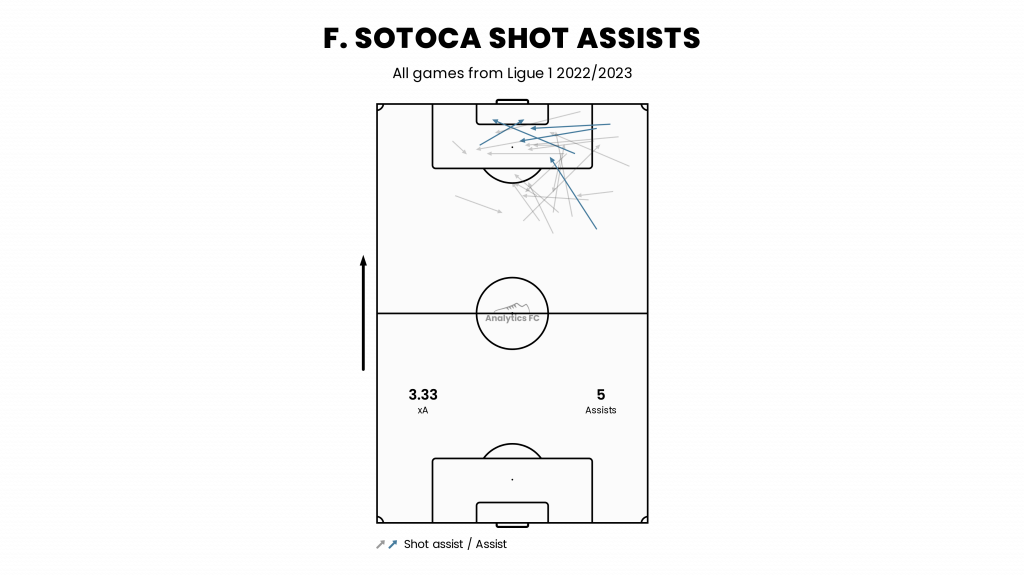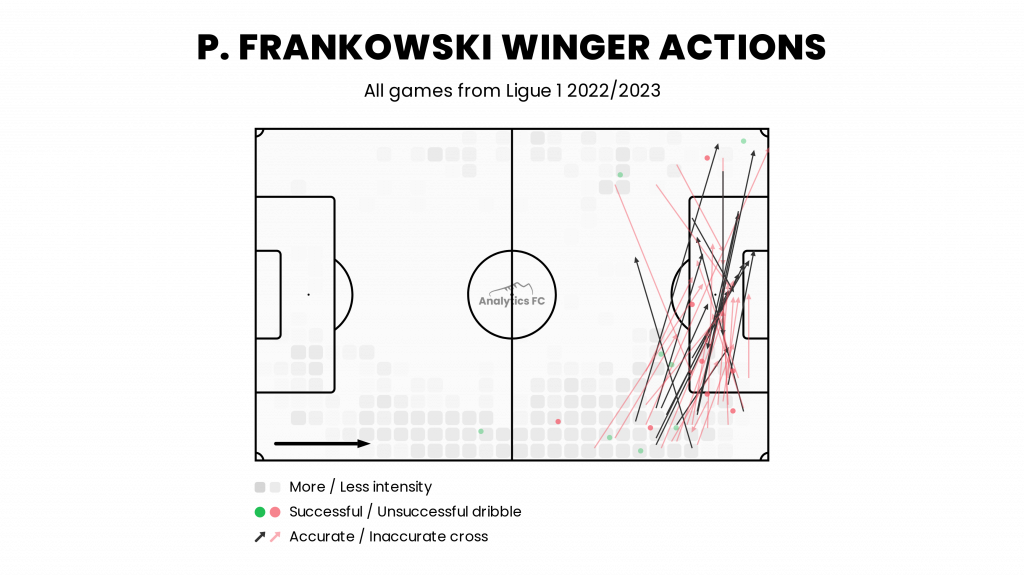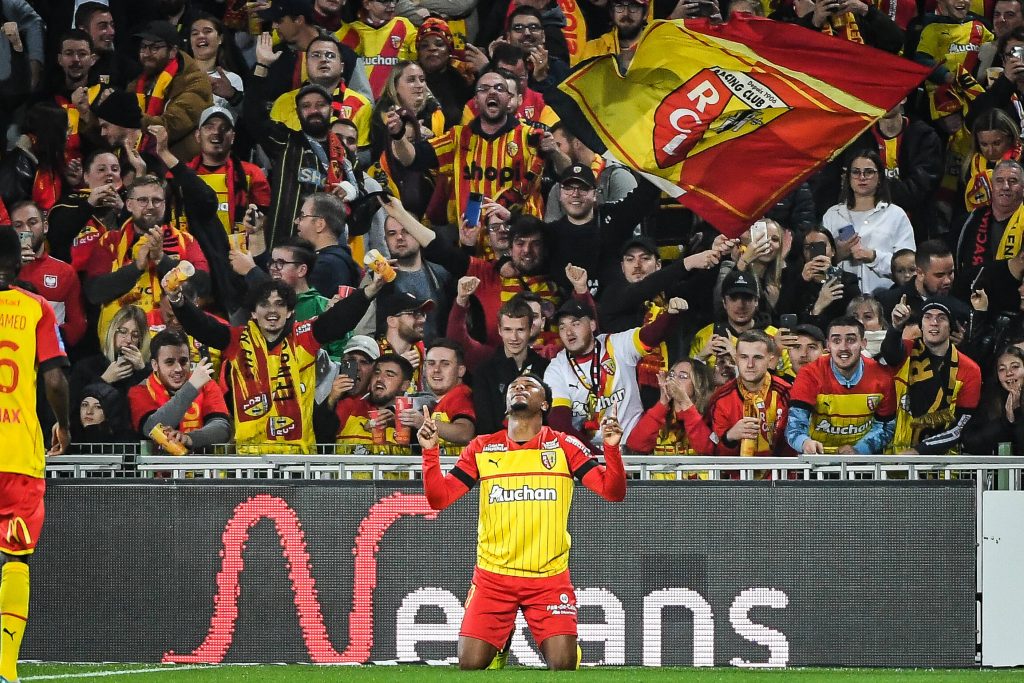Neel Shelat takes a look at another Ligue 1 side doing intriguing tactical things
From an outsider’s perspective, the French Ligue 1 might not seem the most exciting league given Paris Saint-Germain’s domination and the gulf of talent between them and the rest of the division. However, as is the case with many such leagues, looking beyond the very top of the table can yield interesting results.
We have previously discussed how Lorient’s unique style of play has propelled them into the top half of the table this season, and now, we will be taking a look at another such team exceeding expectations – RC Lens.
Based in the northern French city of Lens, which was known for its coal mines until they shut down in the 1980s, the club has always maintained close, local connections to the working class. In fact, for much of their early history, Lens’ squads included workers from the coal mines.
After their professionalisation in the 1930s, Lens spent most of their time in the top-flight without really competing at the very top. The club went through some tough times in the 1960s as the city’s coal mining industry faced a crisis. The industry had to cut ties with the club and released a number of workers, among whom were those who played for Lens but earned their bread and butter in the mines. However, intervention from the local government kept them afloat.
In the 1980s, a private takeover led by a local business steered Lens in the right direction. They enjoyed their heyday in the last years of the 20th century, winning their only Ligue 1 title in 1998 (they also won the cup the following season) and reaching the UEFA Cup semi-finals in 1999/2000.
After that, though, Lens’ trajectory went downwards again, which is why they have spent the majority of the last decade and a half outside Ligue 1. In early 2020, they parted ways with Philippe Montanier and promoted reserve team head coach Franck Haise to a first-team role as their promotion push was starting to derail. Haise did lead the side to some good results, but Lens were helped by the early suspension of the season due to the COVID-19 pandemic as they were placed second, just a point ahead of Ajaccio.
Even though their return to Ligue 1 was rather abrupt, Lens seemed to have everything in place to restore their status as top-flight regulars. As time would show, Haise was an excellent coach who managed to get the best out of his players with a consistent style of play that has remained unchanged after a couple of years.
Looking at Haise’s Coach ID radar over the course of his time at Lens, we can get a basic idea of how his team plays. Their emphasis clearly is on deep circulation, crossing is their most consistent method of chance creation and their defensive style changes against different opposition.
Of course, having clarity of playing style counts for little unless it comes with good results and performances, which Lens certainly have enjoyed. Their xG trendline since their promotion shows how they held their own in the first couple of seasons back in Ligue 1, but have taken things to the next level in this campaign.
Indeed, the league table reflects that. They finished an impressive seventh in the previous two seasons, but are way up in second this season. It would still be unreasonable to expect them to push PSG very far in the title race, but they certainly are well in contention for securing their third Champions League qualification (they reached the group stages in 1998/99 and 2002/03).
There are various factors which have led to Lens’ recent rise which we will discuss, but among the main ones is Franck Haise’s coaching and style of play. The club have recognised this and recently rewarded him with a contract extension till 2027 as well as a promotion to a general manager role.
Much like his preferred playing style, Haise’s formation selection has remained consistent over the last three years. He has almost exclusively set Lens up in a variant of the 3-4-3 formation – usually a 3-4-2-1 or 3-4-1-2.
Midfield Diamond and High Wing-Backs In Possession
As you might imagine based on the heavy emphasis on deep circulation in Haise’s Coach ID radar, Lens can be described as a patient possession-based side. This season, they have kept close to 55% of the ball on average in the league.
Their structure in possession is quite interesting. As aforementioned, Lens’ basic formation is always a variant of a 3-4-3 in that they have three centre-backs, two wing-backs, two central midfielders, two inside forwards and one pure striker on the pitch. Now, the exact makeup of the front line (2-1 or 1-2) mainly depends on their choice of defensive structure, but we will get on to that later. For the purposes of understanding their shape in possession, let us assume their starting formation to be a 3-4-2-1.
From this formation, Lens usually move into a 3-Diamond-3 (3-1-2-1-3) structure in possession, so most of the changes take place in midfield. Generally, the right-sided midfielder moves central as a lone number six would, while the left-sided midfielder moves a little further up. The right inside forward tends to drop back in the halfspace, while his counterpart on the left moves central. The wing-backs push forward, and the striker tends to drift around on the last line but is always poised to run in behind.
Of course, there are various ways to create this sort of diamond structure, and Lens do tend to mix things up in certain matches occasionally. For the most part, though, they have this set pattern, The reason seems to be that Lens have a clear first-choice XI when all players are fit and available.
Their average on-ball positions map from the season shows this structure and the favoured players in each role (note that left wing-back Massadio Haïdara’s average position is a little deeper since he has had to deputise as a left centre-back at times).
We will go on to explore the players are suited to the roles they have been given in this system, but let us quickly understand how Lens operate in possession first. We know that they love their deep circulation, so they are unsurprisingly among the slowest and most intricate sides in Ligue 1.
(Image credit: Peter McKeever and Matt Sisneros for Opta Analyst)
There are few sides in the French top-flight that apply a formidable high press, so in most matches, Lens’ strategy in possession involves getting their 3-1 base close to the centre circle and then breaking down opposition defences from there. Their usage of a back-three proves quite handy in getting up there, as the lateral coverage it offers makes it very hard for opponents to close down all centre-backs.
Therefore, Lens’ wide centre-backs’ ball-carrying is one of their keys in the deepest phase of possession. Facundo Medina is particularly good at getting his side forward with the ball at his feet, which is why he averages the second-highest number of carries per 90 in Ligue 1.

In fact, discounting PSG players, Lens’ three first-choice centre-backs make up three of the top four for carries per 90 in the league, so that should tell you all about how important this is to their build-ups.
Once Lens get close to the centre circle, their deep circulation really kicks into gear. They tend to play a number of passes around the back, while the midfield diamond proves handy in offering passing options between the lines and the wing-backs are always ready to receive out wide.
The deepest midfielder, Salis Abdul Samed, has a key role in circulating possession across the back line. While he does look to play forward when the opportunity arises, his main task usually is to act as a link in quickly getting the ball from one side of the pitch to the other. This is why he has completed the third-highest number of short passes in Ligue 1 this season, and his pass map shows a great cluster of sideways passes in midfield.

Playing such sideways passes helps Lens reshape their angle of attack, which in turn enables them to break down opposition blocks. Once again, their wide centre-backs prove key to this. Medina and Jonathan Gradit are first and third in the Lens squad as far as passes to the final third are concerned, with Abdul Samed between them.
In this phase, Lens’ wide centre-backs can be seen pulling out wide and moving quite close to the touchline. This enables them to have time on the ball when they receive it, which means they can choose between carrying it forward, looking down the line for the advanced wing-backs or trying to find a midfielder between the lines.
Medina excels at this too, and his progressive passes map clearly shows these two types of passes originating from out wide on the left.

Beyond the back line, you might have noticed a slight lopsidedness in the midfield diamond, which seems tilted to the left.
The reason behind that is that Seko Fofana operates on the left. The Lens captain is an exceptional player on the ball, not least with his passing, but especially his dribbling and carrying. Therefore, he tends to drop deep or pull out wide slightly on the left in order to help his team progress into the final third, as his heatmap depicts.

On the other side, Florian Sotoca is the man dropping in the right halfspace, but he tends to stay a little higher up or even move out to wing at times. The Frenchman also plays a key role in helping his side break into the final third, but his job is centred around finding pockets of space to receive progressive passes. He has the most progressive receptions in the Lens squad this season by far at 117.
Once Lens break past the first opposition line, they tend to play forward quite quickly. So, after picking up the ball in such dangerous areas, Sotoca’s first instinct is to turn and try to pick out forward passes, often looking for a run in behind.

After Sotoca, Lens’ wing-backs are their chief creators. The ambipedal Przemys?aw Frankowski has been particularly excellent this season, both through his open-play crosses and set-piece deliveries.

Frankowski has also mostly played on the right, so his team’s shot-ending sequences tend to ramp up on that side more often thanks to him and Sotoca. Ultimately, though, Lens’ chance creation is quite variable, which is why it is so hard to stop them. Their key passes map from the season displays a healthy balance between crosses, through balls and lay-offs in the centre.

Of course, the job is only half done when chances are created, because they count for nothing unless regularly converted. Lens have an excellent striker who does just that, Loïs Openda, who regularly gets on the end of crosses as well as consistently posing a threat with his runs in behind. Those qualities have helped him average the third-highest npxG per 90 in Ligue 1 this season.

In conjunction, all of these pieces have contributed to form the third-best attack in Ligue 1 this season, based on their underlying xG. This is a slight but notable improvement from the last couple of seasons, so this is part of the reason behind Lens’ improved league position at the moment.
Flexible Structures and Approaches Out Of Possession
What is even more impressive is that Lens’ attack has not improved at the expense of their defence. In fact, the central compactness in the midfield of their 3-Diamond-3 structure in possession is very helpful in defending against counterattacks, which is why Les Sang et Or are yet to concede from such a situation this season.
Lens’ settled defence is also as good as their rest defence. They have conceded the fewest goals in Ligue 1 this season and have the second-lowest xGA tally, just 0.6 greater than that of PSG after 17 games played. Unlike their attacking tactics, though, Lens’ defensive strategies tend to vary a good deal from match to match.
Generally speaking, Lens do not apply an intense press but do tend to set up in a high or mid block. Their focus is on containing their opponents rather than actively trying to win the ball back at all times.
Haise’s choice of defensive tactics is mostly influenced by the opposition. We previously mentioned how his selected starting formation can slightly vary between a 3-4-3, 3-4-2-1 and 3-4-1-2, and the main difference between them is seen out of possession.
Against teams that use a 3-2 base structure in possession, for example, a 2-1 structure up front tends to prove more effective. Against teams that start with a 4-2-3-1, say, a more flat front three can work better, whereas the 1-2 up front is seen less often, mostly only when Lens are looking to press against sides that deploy a lone number six.
The big factors in deciding Lens’ defensive set-up are context and game state. In the big games against sides that are also close to the top of the table, Lens may look to drop a little deeper than usual, especially when they have the lead. Obviously, this makes them more compact between the lines and reduces the risk of being played through, but in addition, it gives them the chance to counterattack. While this is not their favoured method of goalscoring, Les Sang et Or can certainly do it well, as was evident in their recent win over PSG.
In short, Lens are quite pragmatic in the way they shape up out of possession. They are neither intense pressers nor very deep defensively, but rather mostly stay in a block higher up the pitch in order to keep their opponents well away from their goal. Here are a couple of stats that sum their defensive approach up: Lens have the second-highest average defensive line height in the league but are only 10th when it comes to high turnovers.
Smart Recruitment and Close-Knit Club Culture
We have given Haise’s tactics a lot of credit so far – and rightly so – but any in-depth piece exploring Lens’ success would be incomplete without acknowledging a couple of other key factors.
Perhaps the most important one is their excellent scouting and recruitment. It would have been quite easy for Lens to have made waves in their first season back in Ligue 1 and then dropped right back off since they have one of the tightest budgets in the division and are always at risk of losing their key players to clubs with much bigger budgets.
In fact, the latter has indeed occurred on a number of occasions in the last couple of seasons. In the summer of 2022, they lost Cheick Doucouré to Crystal Palace for over €22 million but swiftly replaced him by signing Salis Abdul Samed from Clermont Foot for well under a quarter of that figure. As we saw, the Ghanain international has already become a key fixture in the Lens XI. They also spent €4M to bring in 22-year-old Jean Onana from Bordeaux, who has also looked good and can be considered one for the future
Their talisman in 2021/22 was Arnaud Kalimuendo, but he had been brought in on loan from PSG and made a permanent move to Rennes in the summer. Les Sang et Or brought in Loïs Openda to succeed him, and that too has worked out brilliantly. Additionally, they were facing a bit of an injury crisis in the goalkeeping department at the time, so they brought Brice Samba in from Nottingham Forest for just €5M. He currently is the best goalkeeper in the league based on goals prevented according to the PSxG model. The list continues, but the point is clear – Lens have done some of the smartest business not just in France, but in all of Europe’s top-flight leagues.
These new signings join a club and squad that appears to be one of the most harmonious in France. Lens still play at the Stade Bollaert-Delelis, which has been their home since 1933. Its stands are always packed full of incredibly passionate fans that voice their support almost regardless of what is happening on the pitch.
Unsurprisingly, the fans, players and staff seem to have a great connection. Their post-game celebrations after the recent win over PSG showcased this.
?? ÉPISODE 9 : Olélé, Olala … Ils ont chicoté le leader !
— Prime Video Sport France (@PVSportFR) January 1, 2023
Des images magnifiques avec Franck Haise comme capo. #RCLPSG #Ligue1UberEats #PrimeVideoLigue1 pic.twitter.com/9km1bRVmeY
This fan support obviously is something that the players cherish. Just a few months ago, captain Seko Fofana, who was the subject of interest from a number of Premier League clubs over the summer, signed a contract extension at Lens. He did so right after one of their league matches in the middle of a stadium full of fans, who watched on and celebrated.
? Stade Bollaert-Delelis
— Racing Club de Lens (@RCLens) September 1, 2022
? 37 161 cœurs artésiens
? 23h05
Le rond central comme zone de vérité.#CaptainSeko est Artésien et le restera ???#Seko2025 pic.twitter.com/gxlWFo50kT
The squad also looks to be one of the most closely-knit in the league, as was evident when they collectively celebrated Jonathan Clauss’ first-ever call-up to the French national team last summer.
? Ce rêve bleu… @Djoninho25 n'y croit pas, c'est merveilleux ??#SiFierDEtreLensois pic.twitter.com/kKsh3ePuna
— Racing Club de Lens (@RCLens) March 17, 2022
Of course, it is very tough to confidently comment on squad dynamics as an outsider, but by all accounts, Lens seem to have a great group of players that get along very well, and that can only be beneficial for their performances.
Discussion and Conclusion
After two very impressive seasons following their return to Ligue 1, Lens look set to take things to the next level in 2022/23. They are second in the table fully on merit, as their underlying numbers and performances clearly indicate that they deserve to be right up there. At this rate, all signs seem to indicate that they could be well on course to securing their first-ever qualification to the UEFA Champions League.
Given their recent success and their manner of achievement, Lens unquestionably are a model club that almost every other team can look to learn from. They have consistently exceeded expectations relative to their resources and squad, largely thanks to the excellent coaching of Franck Haise and his staff, supplemented by their brilliant recruitment. Even beyond this season, the only way seems to be up for Les Sang et Or.
Stats not from Analytics FC visualisations courtesy Transfermarkt, Opta via Fbref and Opta Analyst, Soccerment, Markstats and Vizz App.
Header image copyright Imago/ZUMA Wire














